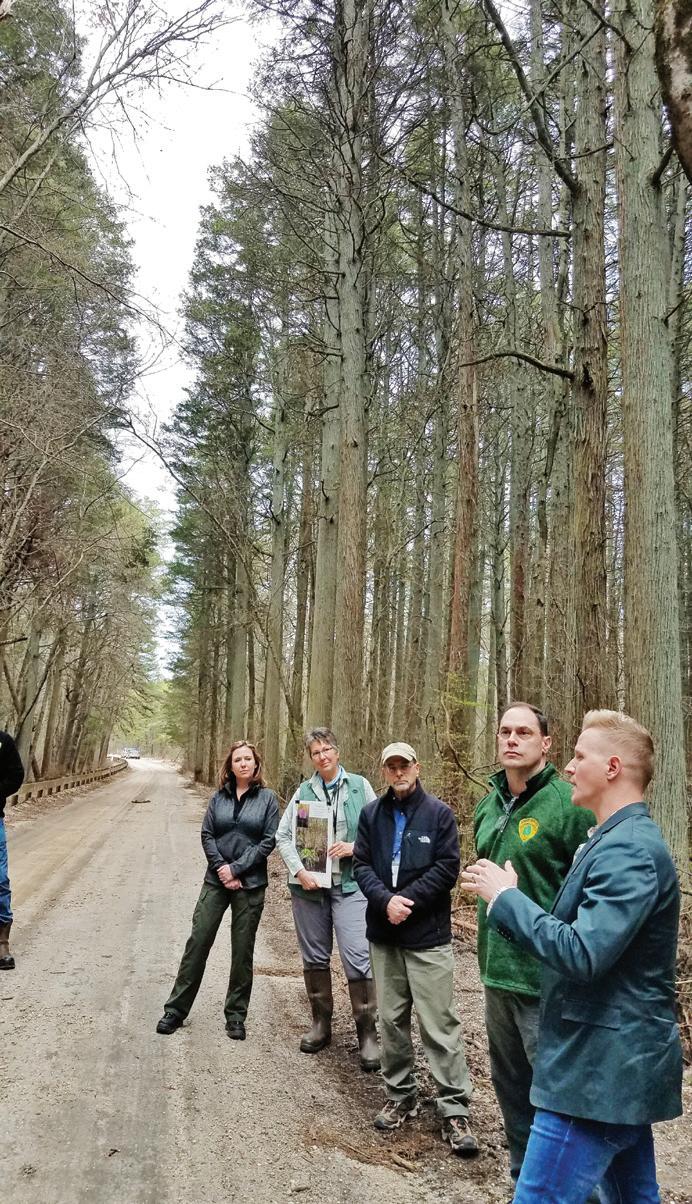Page 10 ♦
LOCAL NEWS / FEATURES
Photo By Bill Bonvie
A mature stand of Atlantic white cedars is shown to reporters by a group of state Department of Environmental Protection officials. From left are Elizabeth Dragon, assistant commissioner for Community Investment and Economic Revitalization; Kathleen Walz, ecologist for the N.J. Natural Heritage Program; Robert J. Cartica, administrator of the Office of Natural Lands Management; Assistant NJDEP Commissioner John Cecil, and NJDEP Commissioner Shawn M. LaTourette.
CEDARS
(Continued from Page 1) dead Atlantic white cedar trees. But that 25,000 or so acres, one official said, still represents “one of the last strongholds of the cedar resource on the
CANNABIS (Continued from Page 3)
of last year. The operation planned for Old Indian Mills Road and Route 206 was also the subject of similar resident concerns once the plan became known, with Gimble replying at the time that establishing cannabis businesses in the municipality has “been a conversation for two years or more” and those conversations have looked at establishing cannabis firms in locations “that are not as dense” versus “some places in town.” An ordinance introduced at the April 5 meeting, tentatively scheduled for passage in May, would amend Shamong’s current Cannabis Zoning Overlay Ordinance, adopting recent recommendations of the Pinelands Commission, to primarily remove a “corn maze of an Adventure Farm,” across from Mighty Joe’s on Route 206, as being one of the areas designated for cannabis use, “with the understanding we are going to continue the conversation about rezoning that piece to put it back in.” A “swap with Pinelands,” according to Heinold, is also on the table. The reason for the recommendation, Heinold noted, is because the lot is considered a “different type of commercial” property. “There were very limited issues they had with our ordinance,” said Heinold of the Pinelands Commission review, noting the only other change of real significance is to remove cannabis use for a forested area near “Murphy’s Pit” on Atsion Road.
WWW.PINEBARRENSTRIBUNE.COM Eastern Seaboard,” with the latter only having 125,000 acres of Atlantic white cedars left. That’s why the department has now embarked on an ambitious effort to restore 10,000 acres of these versatile and valuable but slowly vanishing trees—one being billed by NJDEP Commissioner Shawn M. LaTourette as “the largest forest restoration project ever undertaken in New Jersey and the largest ever in the nation restoring Atlantic white cedars.” The project, which will be conducted in state forests, parks and wildlife management areas, will be funded not with tax money, but rather with some $190 million in damages recovered from polluters of state-owned lands, including settlements with manufacturers and distributors of gasoline containing methyl tertiary butyl ether (MTBE) that contaminated groundwater and surface water throughout the state. The agency’s approach to the restoration, as Assistant NJDEP Commissioner John Cecil explained it to the Pine Barrens Tribune, is to focus on areas where cedars are already present “to leverage as many of the existing trees as possible, rather than cultivating new ones, to the extent that we can work with nature to solve the problem, or to create the conditions where they can naturally regenerate.” “But we’re not looking at places where they’re dying,” he added. The latter type of locale, known as a “ghost forest,” was one of the sites shown to reporters on the tour—a haunted-looking area of dead cedar trees that officials said had been killed by flooding due to beavers having built a dam in the immediate vicinity, rather than the type of saltwater incursion that is causing similar die-offs of cedar forests to occur in areas closer to the coast. Beavers, however, aren’t the only natural threat to the health of Atlantic white cedars, as the NJDEP officials indicated. So are white-tailed deer, who are fond of nibbling on young saplings and often have to be fenced out of areas—in one case, using a solar-powered electric fence—where new cedar tree growth is being encouraged, as
However, what remains among the areas designated for cannabis operations in town is the 123-acre sand pit itself, as well as a neighboring 16.5-acre landfill, where a solar farm is currently proposed, with the former parcel referred to locally as also “Big Horn Sand Pit,” in addition to Murphy’s Pit. Heinold, on April 5, noted that Big Horn Sand Pit Solar Farm, LLC, of Holmdel, commonly referred to as “Big Horn Solar,” whose parent company is CEP Renewables LLC, a designated redeveloper for the pit and landfill, would be “given the option” in a proposed redevelopment plan unveiled on April 5 to provide for a cannabis use. “Their intent is to put solar in,” Heinold explained. “A secondary potential use is cannabis use.” The reason the proposed cannabis use would be secondary, according to Heinold, is the redeveloper currently doesn’t have an “identified user” for cannabis and putting in such an operation “is not really at the forefront of what they are trying to accomplish.” “This plan only deals with solar,” said Heinold of the proposed ‘Atsion Solar Redevelopment Plan,’ adding that “it may need to be amended if a cannabis use comes forward.” Heinold revealed, in response to a question from Shamong Deputy Mayor Michael Di Croce, who previously revealed his intent to make Shamong the “pot capital” of the state, that “if there is a cannabis use on the site, it would integrated into a solar canopy.” “If you think about it, you have a whole solar field out there, and the idea would be to solar the whole thing around it and put solar
Saturday, April 30, 2022
A “ghost forest” created by flooding from the beaver dam at right.
Photo By Bill Bonvie
well as wildfires and competition from other types of trees, such as red maples and gums, which tend to take over locations that have been previously stripped of cedars, and which occasionally require removal with heavy equipment so that new cedars have the room and sunlight they require to grow and thrive. “The removal of all that cedar (for building purposes) made it easier for other species to move in and made it harder for the cedar to re-establish itself,” LaTourette maintained. “The public is then deprived of the benefits of the cedar.” Those benefits to the environment, LaTourette explained to the group, go beyond beautifying it. The root structure of the trees, for instance, is “absolutely phenomenal at holding back flood waters, or filtering the surface water and making our groundwater more suitable for drinking”— something especially valuable to people in areas where municipalities aren’t piping in their drinking water and residents must rely on having potable well water. It also moves a substantial amount of carbon out of the atmosphere by storing it in the soil, he said. In addition, he obser ved, Atlantic white cedar forests provide “a very stable environment over a long period of time”—a point illustrated by the final stop on the tour,
an extensive stand of mature, 40-60 feet tall trees, which, if all goes well, those overseeing the project are hoping to replicate. Not only is this particular cedar swamp “one of the oldest in the country,” explained Robert Cartica, administrator of New Jersey’s Office of Natural Land Management, but it is also one that supports a number of rare plant species, about 350 of which are listed as endangered, including “a really stunning member of the lily family,” and “50 that are totally rare” and “found nowhere else in the world” other than New Jersey. “This is what we’re aiming for,” LaTourette declared. “It’s going to take a little while … putting the Atlantic cedar back in places where it’s going to take root and provide habitat for other species … and give New Jersey residents something to enjoy at no cost to them.” T he NJDEP re storation prog ra m, the commissioner maintained, is also a prime example of how investments made in nature can also benefit society at large, challenging the idea that we must choose between protecting the environment and protecting the economy, which he contended has “always been false.” “We created this program of community investment and economic revitalization to turn that notion on its head,” he added.
on the roof, things like that,” said Heinold of what a combined solar and cannabis use would look like for the tracts. The plan, however, according to Heinold, is “essentially part of the rehabilitation designation process,” which will allow the solar company “to make certain applications to the state” to “try to get approved for solar on the site.” Among some of the preliminary details in the proposed plan, which will become official upon the Shamong committee approving another ordinance on second reading, tentatively scheduled for May, is that the front yard setback for the proposed solar facility has been increased to 65 feet “for panels and equipment,” and that the “solar will be in the pit” so that there is “already a natural point at the site where it drops off” (or drops out-of-sight). The proposed plan also, according to Heinold, calls for “some enhanced buffering to be considered relative to the landfill site,” which is the “only side with an immediate residence next to it.” “There is discussion about a vegetation and landscape plan,” Heinold added. “When you pass by the front of that site, we are not talking about an open farm field or open vacant piece of property. We have a fairly decent woodline existing across there. The idea is not to clear-cut, but to maintain that vegetation, and where needed, put additional vegetation so as to screen and buffer appropriately.” “Rather than a straight-shot driveway that would give you a straight view into the pit, there would be an angle driveway so that the woodline can sort of continue to act like a
natural buffer.” The proposed plan, the township solicitor contended, will allow the township to “require sufficient screening,” and calls for a “bonding requirement for screening” so the redeveloper “cannot walk away” should the vegetation that is planted die, and the parcel “gets maintained.” He noted that the municipal fencing code currently requires a 7-foot fence around a solar facility, but the proposed redevelopment plan (which essentially applies new zoning to the aforementioned parcels) will allow for “a maximum to allow for up to 8-feet height.” Although still under discussion, according to Heinold, a “security sensor” may be favored over barbed wire to “shut the whole thing down if something is being tampered with,” due to the latter often raising liability concerns. Some 30 percent of the pit parcel would contain solar arrays, Heinold noted, with the landfill lot having a “pretty high coverage level.” An agreement, the township solicitor noted, is in place “for tax liens on the landfill part of the property.” “It would generate roughly $150,000 in revenue just to give them tax liens to allow them to foreclose on the landfill and acquire the property,” Heinold noted. “It is a dead property for us that is sitting on the tax rolls, collecting no money, and tax liens with no collecting over the years. So that takes that property, puts it back into a taxable benefit for the town, making it a ratable.” Di Croce pointed out that the landfill, back in the 1970s, was a spot where people would See CANNABIS/ Page 13



